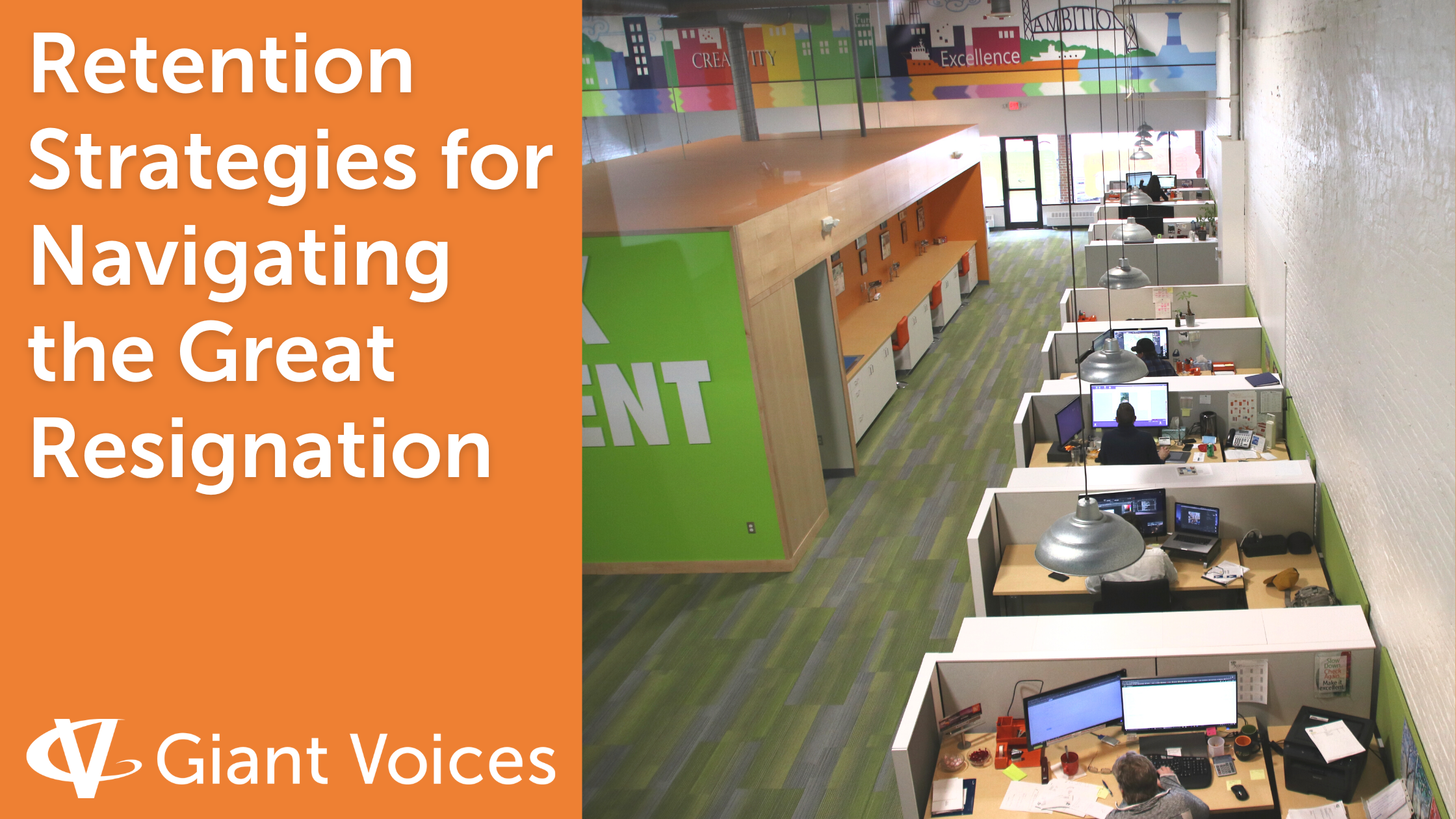It goes by many names. The great resignation. The big quit. Catalyzed by pandemic-related changes in both job structures and employee priorities, workplace turnover has been at an all-time high, and some businesses are more impacted than others.
In fact, a recent study from SHRM Hill found that about 4 million workers left their jobs every month in 2021.
This trend has prompted an increased focus on both recruiting and retention for many companies.
At Giant Voices, helping companies improve their recruiting and retention strategies is one of our core business consulting services. This month, we’re delivering a few key retention tips to help ensure you meet your business goals.

Understanding Workplace Turnover
Some level of turnover is natural in a company. Especially for small business owners, it’s important to remember that an employee leaving doesn’t necessarily mean that you are doing something wrong.
Moving, changing priorities or interest in a new line of work are reasons employees leave happy, healthy workplaces.
Instead of focusing on individual transitions, keep an eye on your employee turnover rate to assess your retention strategy. In general, a 10% annual turnover rate (or a 90% retention rate) is considered strong.
Problems tend to arise when turnover rates are significantly higher than this baseline. High rates of turnover require you to devote time and money to replacing talent, and they can mean that your training and development dollars are benefiting your competitors (instead of your company).
A particularly high turnover rate can also suggest there is dissatisfaction within your workforce or, the incentives you offer are not competitive in the market. In this case, a trusted business consulting partner can help you identify issues and make a strategic plan to improve your retention rates.
Connect Work to Purpose
Burnout can be (and often is) caused by overwork. Recent research, however, suggests burnout is less correlated with the amount of work than it is with connection to a sense of purpose.
An employee working 45 hours a week is not a high burnout risk if she feels that her work is moving her towards her personal goals, whether those are related to finances, skill development, career advancement, or helping her company grow.
This same employee, however, might burn out working 20 hours a week if she feels that her efforts aren’t serving a purpose.
To help your employees connect their efforts to outcomes, make sure to recognize and reward strong performance and to provide clear pathways for skill development and advancement within your organization.
Foster a Culture of Feedback
Feedback is key for any healthy community. It can also be difficult to give and receive. To combat this, establish a structure (such as quarterly or annual reviews) to provide employees with consistent feedback, both reinforcing (or positive) and change-oriented (or constructive).
It’s also important to empower your employees to give feedback. Although employees can be reticent to provide feedback up the chain of command, feedback is a key source of information for leadership.
An environment in which an employee feels comfortable telling her boss if she is dissatisfied with an element of her job is one in which her boss can decide whether or not to make a change.
It’s also an inherently healthier environment than one in which the employee kept silent. In giving feedback, she is demonstrating both trust that her supervisors will accept the feedback in good faith and a continued investment in her workplace community.
To encourage a two-way flow of communication, make it a habit to ask your employees for feedback and demonstrate your appreciation of their input.
Although you might not be able to grant all requests, you can build goodwill by thanking an employee for giving feedback, giving true internal consideration to their comments, and following up accordingly.
This demonstrates professional respect and encourages open communication in the future, even if the ultimate answer is that you are not currently in the position to make a requested change.
Learn From Exit Interviews
Conducting exit interviews is one way employers gather feedback from their departing employees. Your exit interview should aim to find out why an employee is leaving, what aspects of their experience were optimal, and what could have been improved upon.
As with internal feedback, the objective of these interviews is not necessarily to learn what you should have done differently—it’s more so taking advantage of a moment in an employee’s tenure when they may be feeling both particularly reflective and comfortable speaking about their experience working at your company.
Keeping exit interview data on hand and watching for common themes can help you determine whether or not changes in your workplace policies or compensation structure are necessary to improve your retention rate.
Final Thoughts
Business owners and entrepreneurs are responsible to many parties. You need to keep your customers happy, forge strong relationships with partners, maintain workplace satisfaction, and monitor your bottom line, which is much to consider! There’s a reason that C-suite superheroes learn to prioritize self-care early on.
If you’re struggling with high turnover or retention and recruitment, a third-party consulting firm like Giant Voices can help. We will identify the root causes, and develop and implement—in tandem with your team—strategies that align with your business goals. To get started, just reach out.


